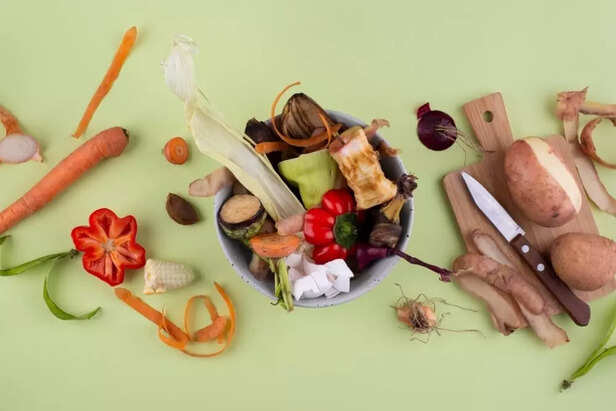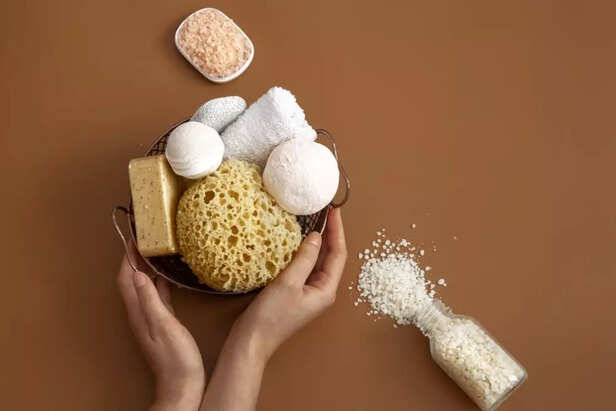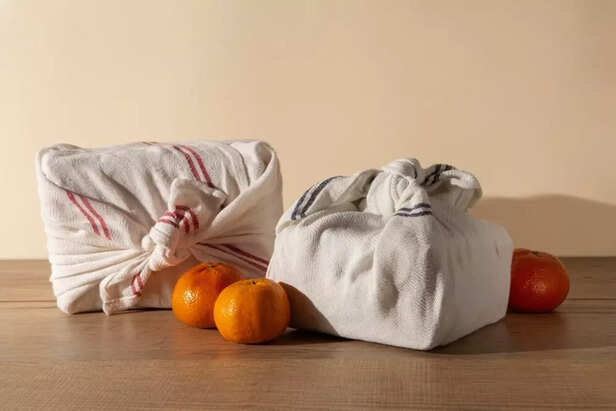Still Throwing Away Scraps? Turn Your Kitchen into a Zero-Waste Paradise!
Shumaila Siddiqui | Sat, 26 Apr 2025
This article shares zero-waste kitchen tips inspired by sustainable Indian kitchen practices, focusing on reducing waste through reusing food scraps, composting, and mindful shopping. It highlights eco-friendly kitchen practices like using natural scrubbers, energy-efficient cooking, and biodegradable cleaning products to create a more sustainable and resourceful kitchen.By adopting these practices, individuals can transform their kitchens into eco-friendly spaces, honoring India's resourceful cooking traditions while promoting sustainability.

Photo:
In today's world, where environmental issues are more pressing than ever, the concept of a zero-waste kitchen has become a crucial part of sustainable living. Inspired by ancient Indian traditions, which emphasize resourcefulness and a deep connection with nature, this lifestyle encourages us to reduce waste, recycle, and use every bit of what we have. From reducing food waste to repurposing everyday items, here’s how you can create a zero-waste kitchen inspired by Indian culture.

Indian kitchens have always been about using every bit of what’s available, minimizing waste through creativity and ingenuity. This "jugaad" mentality is deeply rooted in Indian culture and can be applied to modern kitchens to reduce waste and make the most of every ingredient.
Example: Try making a tangy chutney using the peels of a raw mango or papaya.
Example: Turn leftover rice into a savory rice upma or use it for a quick rice porridge with a little jaggery.
Example: Make banana bread or smoothies from overripe bananas or turn them into a simple banana fritter.
This practice helps us reduce food waste, nourish ourselves, and connect with the resourceful ways our ancestors used to live.
In many Indian households, composting has been a long-standing tradition. Instead of sending food scraps and organic waste to landfills, composting allows us to return valuable nutrients back to the earth, benefiting both our gardens and the environment.
Example: Instead of discarding onion skins or potato peels, compost them to fertilize your garden plants, enhancing their growth.
Example: After soaking dal or rice, use the leftover water to nourish indoor plants or garden vegetables.
By composting and reusing water, you make your kitchen more eco-friendly while contributing to a healthier, greener environment.
Mindful shopping is an essential aspect of building a zero-waste kitchen. Indian grocery shopping has traditionally revolved around buying items in bulk, which significantly reduces waste and unnecessary packaging.
Example: Visit a local store that sells grains, lentils, and spices in bulk. Bring your own cloth bags or jars to reduce plastic usage.
Example: Store spices like turmeric, cumin, and coriander in glass jars instead of their plastic counterparts. Refill these jars when they run out instead of buying new ones.
Example:Keep a few reusable cloth bags in your kitchen or car, so you always have them when you go grocery shopping.
These simple changes can help you reduce your carbon footprint and make your shopping habits more eco-friendly.
4. Sustainable Kitchen Tools and Practices

Indian kitchens have long used sustainable tools and practices to prepare food. From using traditional metal vessels to eco-friendly cleaning tools, these sustainable habits can be easily incorporated into modern kitchens.
Example: Use a coconut husk scrubber for cleaning pots and pans. It is effective, natural, and can be composted once it wears out.
Example: Use a pressure cooker to cook lentils or rice instead of boiling them on a gas stove, which saves both time and energy.
Example: After rinsing rice or lentils, use the leftover water to water your plants, helping conserve water while nourishing your garden.
By incorporating these sustainable tools and practices, you ensure that your kitchen operations are efficient, eco-friendly, and aligned with sustainable living principles.
5. Zero-Waste Cooking: Traditional Indian Recipes with Minimal Waste
Indian cuisine is a treasure trove of zero-waste cooking techniques. Many traditional dishes are inherently designed to reduce waste and make use of every part of an ingredient. Here’s how you can start cooking with minimal waste:
Example: Repurpose leftover rice by blending it with soaked urad dal (black gram) and letting it ferment overnight. The next day, use the batter to make crispy dosas.
Example: Sauté mustard seeds, curry leaves, and vegetables in ghee, then add leftover rice to create a tasty and filling upma.
Example: Mango peels, combined with spices like cumin, mustard seeds, and jaggery, can be simmered to make a tangy chutney.
6.

In addition to reusing, composting, and mindful shopping, here are several simple but effective eco-friendly kitchen practices you can adopt:
Example: Mix baking soda and vinegar to clean your countertops, or use lemon juice to shine stainless steel pots and pans.
Example: Use a cloth towel or napkin to clean up after cooking instead of disposable paper towels.
Example: Replace plastic straws with stainless steel or bamboo ones, and use stainless steel containers for storage instead of plastic ones.
Example: Use beeswax wraps or fabric wraps to store fruits, vegetables, and snacks instead of single-use plastic wraps.
By adopting these eco-friendly kitchen practices, you create a healthier home environment and contribute to a cleaner, more sustainable planet.
A Sustainable Future with Indian Wisdom

Creating a zero-waste kitchen inspired by Indian traditions is a sustainable way to reduce environmental impact, make use of every ingredient, and embrace a lifestyle that values resourcefulness. Whether you are repurposing leftovers, composting kitchen scraps, or rethinking your shopping habits, every small step you take helps protect the environment. By reconnecting with traditional Indian practices, you are not just reducing waste—you are honoring the deep-rooted wisdom that has always celebrated the earth’s resources in a sustainable way.
Unlock insightful tips and inspiration on personal growth, productivity, and well-being. Stay motivated and updated with the latest at My Life XP.
Frequently Asked Question (FAQs)
1. Embrace the Art of Reusing and Repurposing

Creative Reuse
Indian kitchens have always been about using every bit of what’s available, minimizing waste through creativity and ingenuity. This "jugaad" mentality is deeply rooted in Indian culture and can be applied to modern kitchens to reduce waste and make the most of every ingredient.
- Vegetable Peels and Scraps: Instead of throwing away vegetable scraps like the peels of bottle gourd, pumpkin, or even banana peels, transform them into delicious and nutritious dishes. For example, pumpkin peel can be used to make a curry, while bottle gourd peel can be turned into a stir-fry. You can also use fruit peels like mango or pineapple to create chutneys or preserve them in syrup.
- Leftover Rice: Leftover rice, instead of being discarded, can be reused to make fried rice, upma, or even rice puddings. In fact, many Indian dishes are made specifically to reuse leftover food. This practice not only reduces food waste but also adds flavor and variety to meals.
- Fruit Peels and Overripe Fruits: Overripe fruits, especially bananas and mangoes, can be turned into smoothies, baked goods, or even jams and compotes. Similarly, citrus peels can be dried and ground to make a natural cleaning agent or used in a refreshing drink.
This practice helps us reduce food waste, nourish ourselves, and connect with the resourceful ways our ancestors used to live.
2. Composting: Returning to the Earth
- Kitchen Scraps: Items like vegetable peels, tea bags, eggshells, and even coffee grounds can be composted to create nutrient-rich soil for plants. These scraps, when combined with dry leaves or shredded newspaper, can form compost that helps enrich the soil.
- Repurposing Rice and Lentil Water: Water used to soak rice, lentils, or pulses is full of starch and can be used to water plants. This practice not only reduces water waste but also nourishes your plants with essential nutrients, making it a sustainable approach.
By composting and reusing water, you make your kitchen more eco-friendly while contributing to a healthier, greener environment.
3. Smart Shopping: Bulk Buying and Minimal Packaging
- Bulk Purchases: In Indian markets, buying grains, pulses, and spices in bulk is common. This practice allows you to reduce single-use plastic bags and packaging. Using cloth bags or stainless steel containers to carry these items further decreases waste.
- Reusable Containers: Switching from single-use plastic bags to reusable glass or stainless steel containers is a simple but powerful step in minimizing waste. You can use jars to store everything from spices to snacks.
- Cloth Bags: In many Indian households, cloth bags have been used for decades to carry groceries. By using these bags instead of plastic ones, we can significantly cut down on plastic waste, which is one of the leading pollutants today.
These simple changes can help you reduce your carbon footprint and make your shopping habits more eco-friendly.
4. Sustainable Kitchen Tools and Practices

Kitchen Tools
Indian kitchens have long used sustainable tools and practices to prepare food. From using traditional metal vessels to eco-friendly cleaning tools, these sustainable habits can be easily incorporated into modern kitchens.
- Natural Scrubbers: Replace synthetic sponges with natural scrubbers made from coconut husk or dried banana flowers. These are biodegradable and compostable, unlike their plastic counterparts, which end up in landfills for centuries.
- Energy-Efficient Cooking: The use of pressure cookers, which are staples in Indian kitchens, reduces cooking time and energy consumption. By choosing more energy-efficient cooking methods like induction cooktops or solar cookers, you can further reduce your carbon footprint.
- Water Conservation: Water is a precious resource, and many Indian households have traditionally been mindful of conserving it. Fixing leaky taps, using water-efficient appliances, and repurposing cooking water for plants can significantly reduce water wastage.
By incorporating these sustainable tools and practices, you ensure that your kitchen operations are efficient, eco-friendly, and aligned with sustainable living principles.
5. Zero-Waste Cooking: Traditional Indian Recipes with Minimal Waste
- Dosa Batter (Using Leftover Rice or Fermented Grains): Dosa, a staple in South India, can be made with leftover rice instead of fresh ingredients. This allows you to avoid food waste and gives the dosa batter a distinct fermented flavor.
- Upma (Using Leftover Rice): Instead of discarding leftover rice, transform it into a savory dish like upma. This dish, made with semolina, is often cooked with seasonal vegetables, but leftover rice can be used in place of semolina.
- Chutneys Made from Peels or Seeds: Indian chutneys are a great way to use parts of fruits and vegetables that are usually discarded, such as peels, seeds, and cores. These often-overlooked parts of produce can be transformed into flavorful condiments that complement a variety of dishes.
6. Eco-Friendly Kitchen Practices

Eco-Friendly Kitchen Practices
In addition to reusing, composting, and mindful shopping, here are several simple but effective eco-friendly kitchen practices you can adopt:
- Use Biodegradable Cleaning Products: Instead of harsh chemical cleaners, opt for natural alternatives like baking soda, vinegar, and lemon. These are not only eco-friendly but also effective in cleaning your kitchen surfaces.
- Opt for Cloth Towels: Paper towels contribute to unnecessary waste, but cloth towels are reusable and can be washed again and again. In Indian kitchens, cloth towels are commonly used to clean dishes, wipe surfaces, and dry hands.
- Avoid Single-Use Plastics: Try to reduce the usage of plastic bags, straws, and utensils. Use alternatives like bamboo cutlery, steel straws, and cotton napkins. Many Indian kitchens traditionally use brass or stainless steel utensils, which can be reused for generations.
- Eco-Friendly Food Packaging: In many Indian markets, food is sold in eco-friendly packaging, such as banana leaves or paper bags. Replicating this practice at home can reduce plastic waste. You can also wrap food in reusable cloth wraps instead of using plastic wraps.
By adopting these eco-friendly kitchen practices, you create a healthier home environment and contribute to a cleaner, more sustainable planet.
A Sustainable Future with Indian Wisdom

Indian Sustainability
Creating a zero-waste kitchen inspired by Indian traditions is a sustainable way to reduce environmental impact, make use of every ingredient, and embrace a lifestyle that values resourcefulness. Whether you are repurposing leftovers, composting kitchen scraps, or rethinking your shopping habits, every small step you take helps protect the environment. By reconnecting with traditional Indian practices, you are not just reducing waste—you are honoring the deep-rooted wisdom that has always celebrated the earth’s resources in a sustainable way.
Unlock insightful tips and inspiration on personal growth, productivity, and well-being. Stay motivated and updated with the latest at My Life XP.
Frequently Asked Question (FAQs)
- How do you make a zero-waste kitchen?
By repurposing food scraps, composting, using reusable containers, and minimizing packaging waste. - What is zero-waste concept in India?
The zero-waste concept in India focuses on reducing, reusing, and recycling resources, inspired by traditional sustainable practices. - What are the 5 rules of zero-waste?
Refuse, Reduce, Reuse, Recycle, and Rot (compost).










